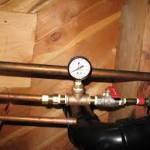Do you have low water pressure?
People that experience low water pressure in their home or office home will find that there are several reasons this could happen. The first step that needs to take place is to see if the water pressure is low in a single fixture or is it throughout the house. The faucet in the kitchen, bathrooms, laundry room, shower heads or outdoors may need to be cleaned or possibly replaced. On the other hand, if the low water pressure is throughout the whole house then there may other issues that will need to be checked and repairs that to be made.
Testing the water pressure is a easy job and all that is needed is the proper water pressure gauge. They are sold at most local home improvement stores. Although there are some townships and municipalities that strictly control your direct water pressure most still try to provide water pressure between 50 to 75 PSI.

When checking your water pressure you will need to make sure that there is no water running anywhere in the home. Take the pressure gauge and attach it with the fittings provide to your faucet and turn on the water and note the reading on the gauge. This reading is called the static water pressure and it should be between 50 to 70 PSI. If the reading is above 40 PSI then it is probably not a water pressure problem but a water flow problem in the plumbing of the house. If the reading is below 20 PSI and then the company that provides the water service should be contacted. Remember, to check all of the faucets or water valves to see if they are closed, before performing this test.
One of the first things to check if your pressure is low is the PRV (pressure reducing valve) and it is usually located by the main household shut off water valve and part of the installed plumbing of the house. It can sometimes be checked by turning the hex head nut located on top of the unit to adjust the valve and see if the water pressure has increased or decreased. It is important to retighten the lock nut screw on the PRV so that the screw does not adjust itself or turn on with the extra pressure on its own. Make sure it of this.
If your pressure reading in good and you still have low water pressure you might also check the faucet aerators to make sure they not clogged by metals and other mineral deposits. Many faucets have an aerators screens that collect mineral deposits, rust, and debris that can restrict the water pressure. The aerators should be cleaned on a regular basis and you purchase a new one at most local home improvement stores.
Another source of low water pressure can sometimes be the water softener system. If you have had one recently installed determine if the water pressure changed because of the way the installation was done. The easiest way to establish if the water softener is causing a decrease in water pressure is to switch the unit into by- pass mode to see if the water pressure improves. If there is no change then the water softener is probably not the problem.
The low water pressure you may be experiencing can be caused by one of the above or you may need to call a professional plumber to find the problem.
